Students from Coleg Gwent’s Crosskeys campus and sixth formers from St Cenydd and Heolddu schools joined 200 pupils from across Wales on a visit to the Auschwitz-Birkenau concentration camp in Poland. Caerphilly Observer reporter Gareth Hill joined them on the Lessons From Auschwitz (LFA) trip, organised by the Holocaust Educational Trust (HET) 70 years on from the camp’s liberation.
Pictures courtesy of GrahamsImages.com
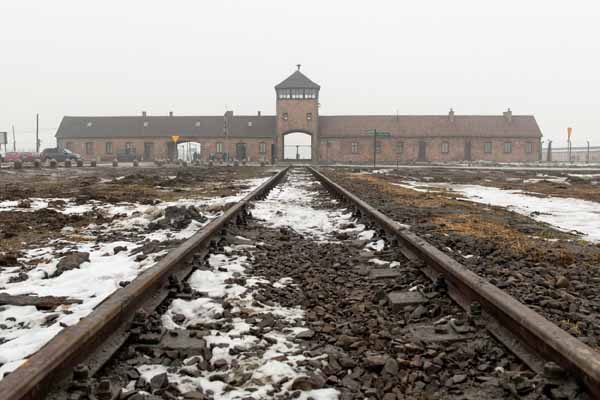
“Arbeit Macht Frei.” Work makes you free – the sickeningly ironic words greeted us on the gates of labour camp Auschwitz 1, part of the largest of the Nazi labour and death camps.
This is the camp where hundreds of thousands of innocent people perished through forced labour, starvation, brutality and disease.
This is the camp where the first tests of the poisonous Zyklon B gas were carried out on 600 Soviet prisoners of war and 250 polish political prisoners selected from the hospital.
The gas was used to kill many of the 1.1 million people who perished at Auschwitz – 90% of them Jews.
The majority of them were slaughtered at the custom built Birkenau. Built for one purpose. Extermination.
Often victims were sent to the chambers hours after they arrived in their thousands, crammed into cattle trucks, torn apart from their families and sent to work or death by a nonchalant hand gesture from a Nazi doctor.
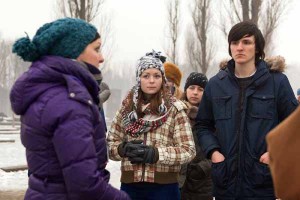
We stood on the platform where the “selection” would have taken place.
The track running through the gate to make the industry of genocide as efficient as possible.
Mothers and children, the disabled, the hungry and the weak, were sent to death or for experimentation because they couldn’t be used to make a profit or participate in the war effort.
We walked the path along the tracks in the freezing snow, where the dehumanised were marched into the gas chambers 2,000 at a time before being tossed into the incinerators.
Not by Nazis, but by prisoners like them, forced to send their own people to their deaths and then forced to destroy the evidence.
We saw the belongings of those who thought they were going to relocate to a new home in the east, away from the persecution they’d suffered in Europe.
The suitcases carrying the names of those transported from Greece, Hungary, Germany. The names of those who were to become anonymous in ash.
These were the victims of a crisis of a system that failed. Of a society that failed when it was needed most.
Poland had been a slight refuge from anti-Semitism and home to three million Jews until the armies of the Third Reich arrived. Oswiecim, the Polish name for the Germanised Auschwitz, had a 58% Jewish population before the war. Now none remain.
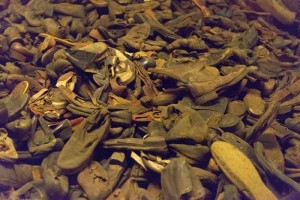
We saw countless piles of shoes beyond comprehension. Children’s shoes, baby clothes, a doll with its face smashed.
A tiny insight into the lives of the individuals who perished.
We also saw the hair of women long-suffocated and cremated. Saved to make garments.
Mountains of hair, of all colours, still in buns and pony tails, hacked off after its owners were gassed.
We saw where those who were kept for labour lived. In wooden sheds, 700 to a room, ten to a bunk where the strongest were lucky to get the top. The weakest left to sleep in the effects of the dysentery suffered by those above.
There was a sense of injustice as we stood outside Gas Chamber Number 1 in view of Auschwitz Commandant Rudolph Hess’ house, the place where he lived with his family in luxury.
In view of the homes where the SS guards lived, Alex Fender, an Educator with HET, said: “Everyone who worked here made choices. The German people made choices.”
The 200 pupils gathered in the dark and cold for a ceremony at the memorial for the dead, situated between the remains of Gas Chambers 2 and 3.
The SS had destroyed them to try and hide their crimes, as the Soviet Red Army approached in January 1945.
The memorial reads: “For ever let this place be a cry of despair and a warning to humanity, where the Nazis murdered about one and a half million men, woman and children, mainly Jews, from various countries of Europe.”
Speaking after readings from students and before the lighting of candles, Rabbi Marcus, of Central Synagogue London, warned against a repeat of the Holocaust, with victims not necessarily Jewish but from any minority.
He made reference to the far-right Jobbik party in Hungary, with seats in parliament, and Golden Dawn in Greece, as evidence to rising fascism and anti-Semitism in Europe.
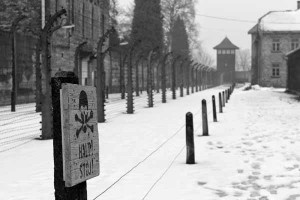
The rabbi also warned of rising anti-Semitism in the UK where incidents rose to more than 1,100 last year, according to the Community Security Trust, on top of other hate crimes.
He said: “People ask me how did God allow this to happen. I say that’s the wrong question. You should be asking how did man allow this to happen?”
Returning from the death camp, many students needed time to come to terms with what they had seen before they could share their thoughts with peers as ambassadors for HET.
Many said a gallery of pictures of victims and their families had moved them most as they gave human faces to the dead.
Coleg Gwent student James Horton, 18, said: “It’s quite important to get the scale of it as we know the numbers but when you see the scale of the construction it’s massive. You can become desensitised but going there it becomes more than just schoolwork.
“It’s more important than ever to visit as the survivors are dying of old age so we need people with experience and second-hand knowledge to pass it on as before long it’s going to be too late.”
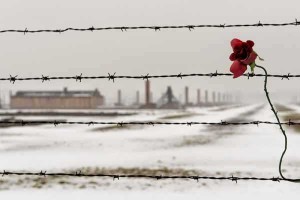
Hannah Davies, 18, also of Coleg Gwent in Crosskeys, said: Seeing the shoes and hair showed the extent to which they were willing to go. You learn stuff you didn’t know before, like how they put ash from the burnt bodies in the river.”
Speaking to the pupils as they gathered their thoughts on the flight home, Tom Jackson, education officer for the LFA project, said: “There’s been a rise in anti-Semitism across Europe. There’s been a rise in Islamopobia.
“We’ve seen today what happens when prejudice goes unchallenged.”
